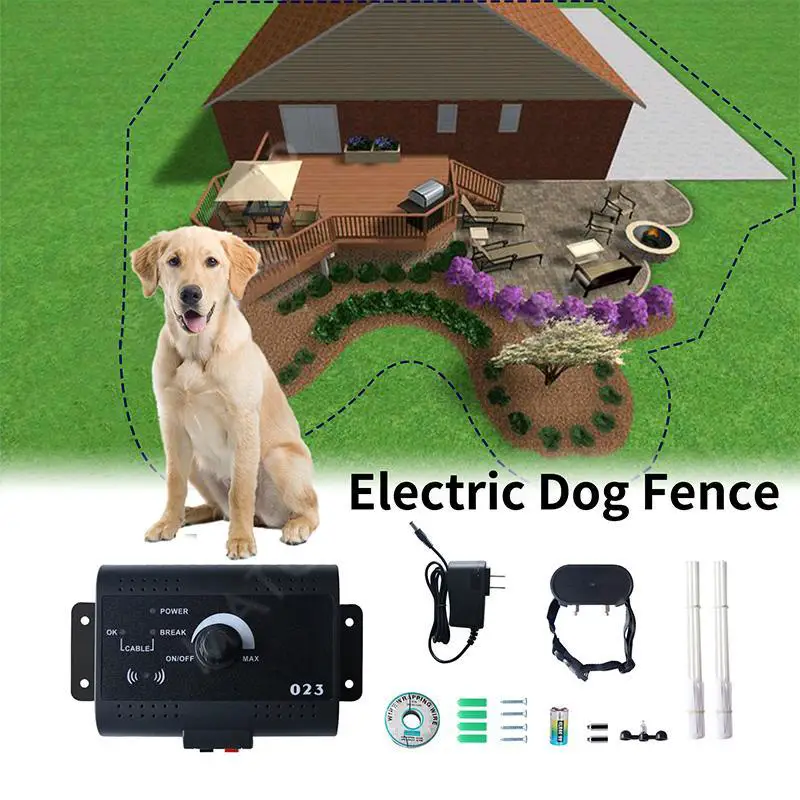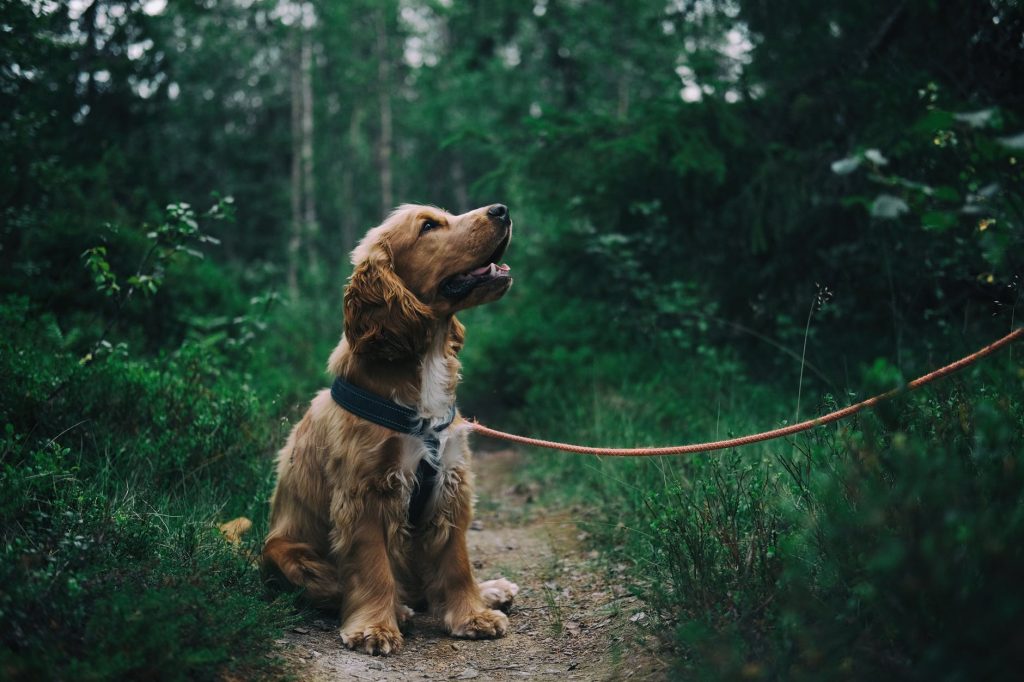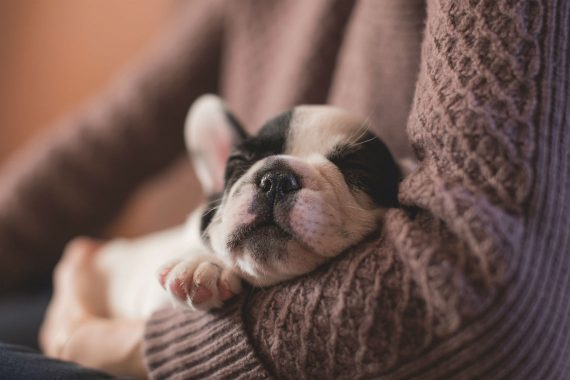One of the first steps you should take after adding a new furry member to your family is to train him to potty at the right time and place.
You don’t want your puppy to mess up your whole place.
Some puppies will respond quickly, others will struggle for a little while. The question on most dog parents minds is what is the best way to potty train a dog to ensure a perfect outcome
In this article, we gonna give you our step by step guide of The Best Way to Potty Train a Dog in 15 Easy Steps.
But let’s first answer some of the questions you might have and clear some things that you should know before starting your pup’s potty training regime to help you and your puppy take the first step towards a long and happy life together
Let’s start, Shall we?
Table of Contents
The Best Way to Potty Train A Dog
First, preparation is the key to do potty training right. So let’s discuss all the equipment you gonna need to be perfectly prepared for this chore

Tools Needed for Potty Training
You’ll need the following items as you begin potty training your dog:
- A properly-sized crate: a crate is essential to keep your puppy safe when you can’t watch him. This will also help him learn to hold it because of his desire to keep his den clean.
- A leash: you may have a fenced-in yard, However, you need to take your puppy out on a leash so that he isn’t tempted to play instead of potty. A leash will help you be close enough to your puppy to reward him immediately after elimination.
I personally use this Reflective Hands-Free Dog Leash to Enjoy All Outdoor Activities with my Dog! 
- Treats: This is to reward your pup for going in the proper spot.
For a more fun way with treating your dog check this Treat Dispenser Ball 
- Baby gate: You need a baby gate to keep your puppy from sneaking away to other parts of the house unsupervised. You can use The Wireless Invisible Dog Containment Fence. It’s easy to use to keep your dog safe, set clear boundaries, and no installations required.

- You can take The Wireless Invisible Dog Containment Fence with you anywhere.
- Stain and odor remover: using the right kind of cleaner will prevent your puppy from seeking out spots that he’s already soiled.
Why Potty Training?
Among the top reasons why dogs lose their homes and end up in shelters is house soiling.
Most dog owners can be willing to put up with a dog destroying rugs and flooring or shedding piles of hair over their furniture but NOT HOUSE SOILING
A stinky mess sitting in a house corner after a hard day at work,
Nobody wants that.
Fact
1 of 10 adopted dogs are returned to their shelters within 6 months

Do you want to miss out on the amazing life you gonna have with your furry buddy Just because of a technicality?
That’s why you should make your research in advance and learn The best way to potty train a dog.
This is exactly why you are here, and that’s exactly what you gonna get.
So, Read on.
How Long Should It Take Me to Potty Train My Dog?
It depends,
There is no certain age or time, it depends on the individual puppy and the amount of time each owner is willing to teach him
4 to 6 months is the optimum period in which most puppies can be potty trained
If you have a puppy, prepare to spend the next three years training your puppy for at least 20 minutes per day.

By the time he is a full-grown dog, all the effort you put into training will pay off and you’ll have a well-adjusted companion and a new best friend.
Generally, most owners are setting their expectations too high.
So for an ideal answer let’s make sure you are doing it right!! shall we?
15-Steps Guide to The Best Way to Potty Train a Dog
Step 1. Introduce Your Puppy to His New Home
When you are new to a place or group, you may be overwhelmed with a mixture of emotions, the same goes with your new puppy. He may be bursting with curiosity, excitement, fear or joy.
Now is the best time to lay out the foundation for a good and pleasant relationship with your puppy.

It is very important to establish the expectations of your puppy and be consistent with them so that your puppy can settle in and learn to trust and respect you and everyone at home
You can achieve that by only showing your puppy the areas where he is allowed to be.
Don’t let your pup to roam and explore on his own, especially, if you don’t want him to do his business there.
For Example,
Close off the upstairs area and bedrooms and do not allow your puppy to explore there.
Step 2. Get to Know Your New Roommate
Do your own research into your puppy’s particular breed behavior and needs.
Make an effort to know your puppy’s breed traits and special needs or any behavior that you should be aware of and look out for.
For Example,
If your puppy is a tiny little chihuahua, their bladder will be very small and they will need to urinate more frequently; accidents will happen even if they are well trained.

Although most dogs are highly intelligent, they don’t think as humans do.
Don’t expect them to understand simple command words immediately, They may be simple for you but for them it’s a whole new thing. Also, Don’t expect them to tell you that they need to pee or poop.
For this reason, you must be willing to understand how they communicate with you and study the clues they give and get from you.
Step 3. Pay Attention to Your Puppy At All Times
Try to have your puppy where you can watch him at all times. This will allow you to look for early signs that he needs to go and help to prevent accidents.

Some of the signs to look for include whining, circling, sniffing, barking, or any sudden behavior change. As soon as you realize any of these signs, immediately lead the dog outside.
Step 4. The potty Zone
Set your mind on a certain area outside and take your puppy there every time he needs to go.
Choose the potty zone and stick to it. Also, It’s preferable to choose an area that is easy to clean
After several times, your puppy will get used to it on his own as the smell of urine will associate the area as his “bathroom.”
Pick an area that is easy to get to quickly. You will be visiting this area frequently during the training process.

Make sure to avoid areas where other dogs go or have recently gone, such as parks, Until your puppy has had his third set of vaccines.
It’s a good idea to discuss this with your veterinarian.
When taking your dog outside, it’s a good idea to keep him on a leash so you can teach him to go in a specific location. You can also more easily keep an eye on the dog, so you’ll know when he is done
Step 5. Accidents Will Happen
During the process of potty training your puppy, accidents do and will happen. The important thing is to clean them up thoroughly.
As we mentioned before Dogs are attracted to spots that they’ve used previously, and remember that their sense of smell is way better than ours.
It’s hard to get Pet urine out, and not all household products will effectively remove odors.
If you notice your puppy going in the same spot, chances are some of that smell has been left behind. You can opt for a product that’s formulated for removing pet urine odors and stains.

All this for when he has already done it
but
What to do when you catch him in the act?
If you catch your puppy in the act of urinating or defecating indoors, make a sudden noise such as a clap, and say the word “NO” Then, quickly lead the dog to his designated potty zone.
Be careful,
You want to startle but not to scare the dog. The intent here is to get his immediate attention and know that you disapprove marking or pooping indoors.
Be consistent, use the same word and/or noise each time.
You may not get the same result if the dog is defecating because most puppies will not be able to stop this. But, you should still do the same thing as part of the teaching process.
Never Punish Your Puppy for Accidents.
Your puppy does not know he is doing anything wrong.
Do not force your puppy to smell or keep reminding him of his actions.
He will not remember and could possibly become scared of you.
When you use punishment to stop your puppy from going indoors, it can confuse your dog and even make it worse. Your pup could only understand that you get mad when you see him potty and will hide from you when he needs to go, most likely in places that are hard for you to reach.
Step 6. Teach Him to Potty on Cue
Set a command word for when you want your puppy to go potty.
Whenever you take your puppy outside to the potty zone, use the word “Go” or “Potty” or pick another command.
In his mind, your puppy will recognize the command, associate it with the action, and understand what you want him to do.

This will help the dog to learn when and where he should be urinating or defecating.
Use that command only when you want him to go to avoid any confusion
Step 7. Praise your puppy like There is no tomorrow
Whenever your puppy pees or poops outside in his designated potty zone, he needs to be celebrated.
Give them baby talk or a treat, jump up & down, pat their little heads & remind them of how brilliant that decision was.

Yes, it might look silly, but your pup needs to know he’s done the best thing ever.
With consistent praise, your puppy will start to understand that it’s the correct decision and the one that leads to super fun happy time.
By doing that, Whenever your puppy feels the need to potty, he will think to himself “I should probably go potty outside because that makes everyone happy”
Step 8. Keep A Schedule
Keeping a schedule of when your puppy is supposed to go potty will make life easier for both of you.
by feeding your puppy at the same times each day, you can now predict and schedule bathroom breaks.
During the initial stages of potty training, It helps to Schedule post-meal walks, as well as hourly trips outside.

Always take your puppy out after crating, even if this was only for a short time, and remember that vigorous play should always be interrupted for potty breaks.
Don’t make the mistake of expecting your puppy to hold it for longer than he is physically capable.
The general guideline for puppy “Hold Times” is that each month of age equates to an hour of “Hold Time” so a two-month-old puppy can hold it for roughly two hours.
Your puppy may be able to hold it for a slightly longer period of time at night as he gets older
Also, he will need potty breaks more frequently when he’s playing.
Step 9. Use a crate when you’re not home
When you aren’t home with your puppy, confine him to an area, such as a crate.
This helps limit accidents in your bedroom, living room, or any other areas when you aren’t there.

Step 10. Figure out How Long Your Puppy Can Hold it For
Young puppies can’t hold their bowels & bladders for long. If you come home to find that they’ve had an accident in there it’s quite possible that they can’t hold it that long.
Generally, As we mentioned earlier, a puppy has the ability to hold his bladder for about one hour per month of age. So if you have a 3-month-old pup, he probably can only hold his bladder for about 3 hours.
So, In case you’re going to be away at work for long periods of time, you should consider getting a neighbor, relative or dog sitter to come over to let your pup out during the day.
Step 11. Control Your Puppy’s Diet
The body of a young puppy is still in development, that’s why puppies have immature digestive systems, so they can’t really handle a lot of food.
That’s why it is recommended that you break up the feedings into three small meals.
Another thing to be aware of is the food itself, which should be the highest quality. Whatever you choose, make sure it agrees with your puppy.

Examining their stool is the best way for an owner to figure out whether it’s time for a change in diet.
If your puppy’s stools are bulky, loose, and stinky, it may be time to talk to your vet about switching to a new food.
Also, Overfeeding may cause a case of diarrhea, which will only make the task of house-training that much more difficult.
Step 12. Schedule Trips Outside Around Meal Times
Keeping a regular feeding schedule goes hand in hand with a regular potty schedule. Right after eating, Puppies usually need to go immediately.
Taking your pup out after every meal will help to reinforce the idea of where they are supposed to go while minimizing the mess.
Step 13. Learn the Signs of Needing to Go
Your new puppy might not speak the same language, but he’s trying to tell you that he needs to eliminate.
Luckily there are certain signs for which you can keep a lookout. Whenever you spot any of the following signs Immediately bring your dog outside to his special potty spot
- Smelling his rear
- Pacing in circles
- Barking or scratching at the door
- Sniffing the floor
- Squatting.
He may show the last sign a bit too late, but be ready to open the door anyways so he will know that his usual area is up for grabs before he goes in the wrong place.

You have to quickly bring your dog outside when you see any of these signs, so plan ahead.
It would help to keep a leash right at the door, allowing you to usher him outside as quickly as possible. And once he learns where his special potty area is, he’ll return to it all on his own.
Just don’t forget to choose the same spot every time your dog needs to relieve himself.
Step 14. The Water Bowl
If your dog is a heavy water-drinker, chances are he’ll be a frequent urinator as well. To avoid any accidents, take your puppy out shortly after drinking during the puppy potty training phase so he’s in the right place at the right time.
Step 15. Attention to Larger Issues
Finally, if your training doesn’t seem to be taking with your pooch it might be worth a trip to the veterinarian. Frequent urinating or defecating in the house can be a sign of a larger health issue.
If there is something you suspect, contact your vet’s office immediately and let him know about your concern. They might simply recommend a simple change to your training routine or a change to his food, but for larger issues, you’ll be glad you called sooner rather than later.
That’s it,
That was our step by step guide of The best way to potty train a dog. Use these steps wisely and carefully and Remember, puppies are fragile creatures and love is the most important ingredient of this equation, So for this to work make sure he feels your love
How to potty train your puppy may seem like a frightful task at first but with practice and patience, it will get easier each time.
So what’s the cutest experience you had while potty training your fluffy buddy, tell us in the comments.
I hope this has helped you and answered all your questions.
If you liked it, share it with a friend. He may have the same questions in mind
And as always, If you liked what you read here and you wanna read more check my other articles on Yulin the Chinese dog eating festival.
If you got any other questions, comment below and let me know, I will get back to you ASAP
Have a nice day and Read you next time

